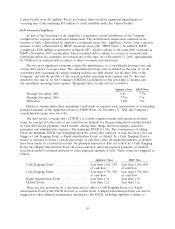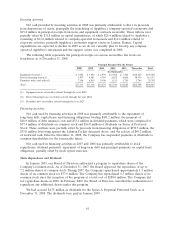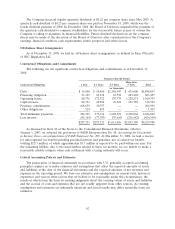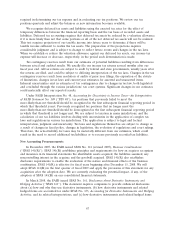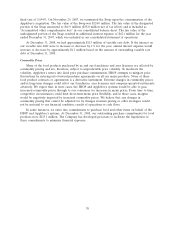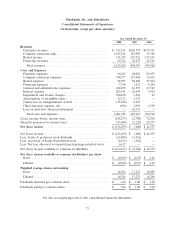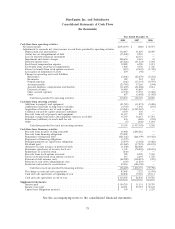IHOP 2008 Annual Report Download - page 83
Download and view the complete annual report
Please find page 83 of the 2008 IHOP annual report below. You can navigate through the pages in the report by either clicking on the pages listed below, or by using the keyword search tool below to find specific information within the annual report.earnings at each subsequent reporting date. Eligible items include, but are not limited to, accounts and
loans receivable, available-for-sale and held-to-maturity securities, equity method investments, accounts
payable, guarantees, issued debt and firm commitments. On January 1, 2008, the Company adopted
SFAS 159 and has not elected to use fair value measurement on any assets or liabilities under this
statement.
In May 2008, the FASB issued SFAS No. 162, Hierarchy of Generally Accepted Accounting Principles
(‘‘SFAS 162’’). This statement is intended to improve financial reporting by identifying a consistent
framework, or hierarchy, for selecting accounting principles to be used in preparing financial statements
of nongovernmental entities that are presented in conformity with U.S. GAAP. While this statement
formalizes the sources and hierarchy of U.S. GAAP within the authoritative accounting literature, it
does not change the accounting principles that are already in place. This statement was effective on
November 15, 2008 and did not have a material impact on our Consolidated Financial Statements.
In June 2007, the EITF reached consensus on Issue No. 06-11, Accounting for Income Tax Benefits
of Dividends on Share-Based Payment Awards (‘‘EITF 06-11’’). EITF 06-11 requires that the tax benefit
related to dividend equivalents paid on restricted stock units which are expected to vest be recorded as
an increase to additional paid-in capital. The impact of adopting EITF 06-11 in 2008 did not have a
material impact on the consolidated financial statements.
Item 7A. Quantitative and Qualitative Disclosures about Market Risk.
We are exposed to financial market risk, including interest rates and commodity prices. We address
these risks through controlled risk management that includes the use of derivative financial instruments
to economically hedge or reduce these exposures. We do not enter into financial instruments for
trading or speculative purposes.
Interest Rate Risk
Our interest income and expense is more sensitive to fluctuations in the general level of U.S.
interest rates than to changes in rates in other markets. Changes in the U.S. interest rates affect the
interest earned on our cash and cash equivalents and investments, and interest expense on our variable
funding notes.
Our short and long-term investments are comprised primarily of certificates of deposits and
auction rate securities that are included in restricted assets related to the captive insurance subsidiary.
We have classified these investments as available-for-sale. Investments in fixed interest rate earning
instruments carry a degree of interest rate risk. Fixed rate securities may have their fair market value
adversely impacted due to a rise in interest rates. Our future investment income may fall short of
expectations due to changes in interest rates. Due to the short time period between reset dates of the
interest rates, there are no unrealized gains or losses associated with the auction rate securities. As of
December 31, 2008, we had investments in auction rate securities with contractual maturities ranging
from 2030 to 2033. Such investments have a weighted average yield of approximately 4.0%. Based on
our cash and cash equivalent and short-term and long-term investment holdings as of December 31,
2008, a 1% decline in interest rates would decrease our annual interest income by approximately
$0.1 million.
On July 16, 2007, we entered into an interest rate swap contract (the ‘‘Swap’’) as a condition of
the acquisition financing with Lehman Brothers Special Financial Inc. (‘‘LBSFI’’), guaranteed by
Lehman Brothers Holdings, Inc. (‘‘LBHI’’). The Swap was intended to hedge our interest payments on
the asset-backed notes that were issued in November 2007 to finance the Applebee’s acquisition. The
Swap sets forth the terms of a five-year interest rate swap in which we would be the fixed rate payer
and LBSFI would be the floating rate payer (the ‘‘Reference Swap’’). The Reference Swap has an
effective date of July 16, 2008, a notional amount of $2.039 billion, a floating rate of LIBOR and a
69


